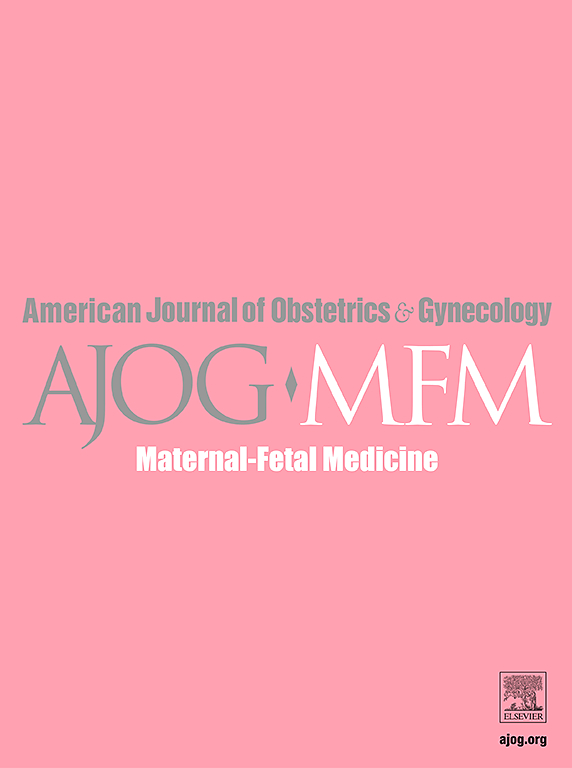Paracetamol prior to catheter balloon insertion for labor induction—A randomized controlled trial
IF 3.8
2区 医学
Q1 OBSTETRICS & GYNECOLOGY
American Journal of Obstetrics & Gynecology Mfm
Pub Date : 2025-01-21
DOI:10.1016/j.ajogmf.2025.101610
引用次数: 0
Abstract
Background
Assessing maternal pain and satisfaction following administration of paracetamol vs. placebo prior to catheter balloon placement.
Methods
Primiparous women at term admitted for medically-indicated labor induction were randomized to receive intravenous paracetamol 1 gram in 100cc normal saline (N=71) or placebo of 100cc normal saline (N=70) prior to catheter balloon insertion. The women were blinded to the intervention allocation. Primary outcomes were visual analog scale (VAS) scores and maternal satisfaction, assessed via questionnaire.
Results
Pre-induction maternal pain did not differ between the paracetamol and placebo groups. Median VAS scores at 2, 30, and 60 minutes after catheter insertion were comparable between the groups: 6.46±2.77 vs. 6.66±2.78, P=.68; 5.53±3.20 vs. 5.93±3.01, P=.46; and 5.83±3.25 vs. 6.49±2.88, P=.26, respectively. For the paracetamol vs. placebo group, the mean sum of VAS scores was lower (4.39 vs. 5.37, P=.045) and the proportion with a mean VAS score <5 was higher (65.2% vs. 44.1%, P=.016). This difference persisted in a multivariate logistic regression analysis adjusted for maternal age (OR=2.2, 95% CI 1.1–4.5, P=.036). After balloon insertion, relatively fewer women in the paracetamol vs. placebo group showed immobility (33.8% vs 50.0%, P=.037) and needed analgesics (31.3% vs. 66.1%, P<.001). Maternal satisfaction score was similar between the groups (P=.877). Cervical ripening, duration from catheter insertion to delivery, and labor and neonatal outcomes did not differ significantly between the groups.
Conclusions
The administration of paracetamol compared with placebo prior to catheter balloon insertion was associated with lower VAS score and less analgesic use and maternal immobility.
求助全文
约1分钟内获得全文
求助全文
来源期刊

American Journal of Obstetrics & Gynecology Mfm
Medicine-Medicine (all)
CiteScore
7.40
自引率
3.20%
发文量
254
审稿时长
40 days
期刊介绍:
The American Journal of Obstetrics and Gynecology (AJOG) is a highly esteemed publication with two companion titles. One of these is the American Journal of Obstetrics and Gynecology Maternal-Fetal Medicine (AJOG MFM), which is dedicated to the latest research in the field of maternal-fetal medicine, specifically concerning high-risk pregnancies. The journal encompasses a wide range of topics, including:
Maternal Complications: It addresses significant studies that have the potential to change clinical practice regarding complications faced by pregnant women.
Fetal Complications: The journal covers prenatal diagnosis, ultrasound, and genetic issues related to the fetus, providing insights into the management and care of fetal health.
Prenatal Care: It discusses the best practices in prenatal care to ensure the health and well-being of both the mother and the unborn child.
Intrapartum Care: It provides guidance on the care provided during the childbirth process, which is critical for the safety of both mother and baby.
Postpartum Issues: The journal also tackles issues that arise after childbirth, focusing on the postpartum period and its implications for maternal health. AJOG MFM serves as a reliable forum for peer-reviewed research, with a preference for randomized trials and meta-analyses. The goal is to equip researchers and clinicians with the most current information and evidence-based strategies to effectively manage high-risk pregnancies and to provide the best possible care for mothers and their unborn children.
 求助内容:
求助内容: 应助结果提醒方式:
应助结果提醒方式:


